
At the beginning of each month, Jan Flamank will create Nature Notes that can be shared online. You can read Jan's notes below, or you can click on each picture to find a page of notes about that topic that you can download.
Be aware though that these pages are in a format that will not work well on small-screen devices such as smartphones or small tablets.
More people have said that they have heard again, for the first time in years, the unmistakable call of the cuckoo. They are one of the migratory birds that fly over here from sub-Saharan Africa, which is an exhausting and dangerous migration.
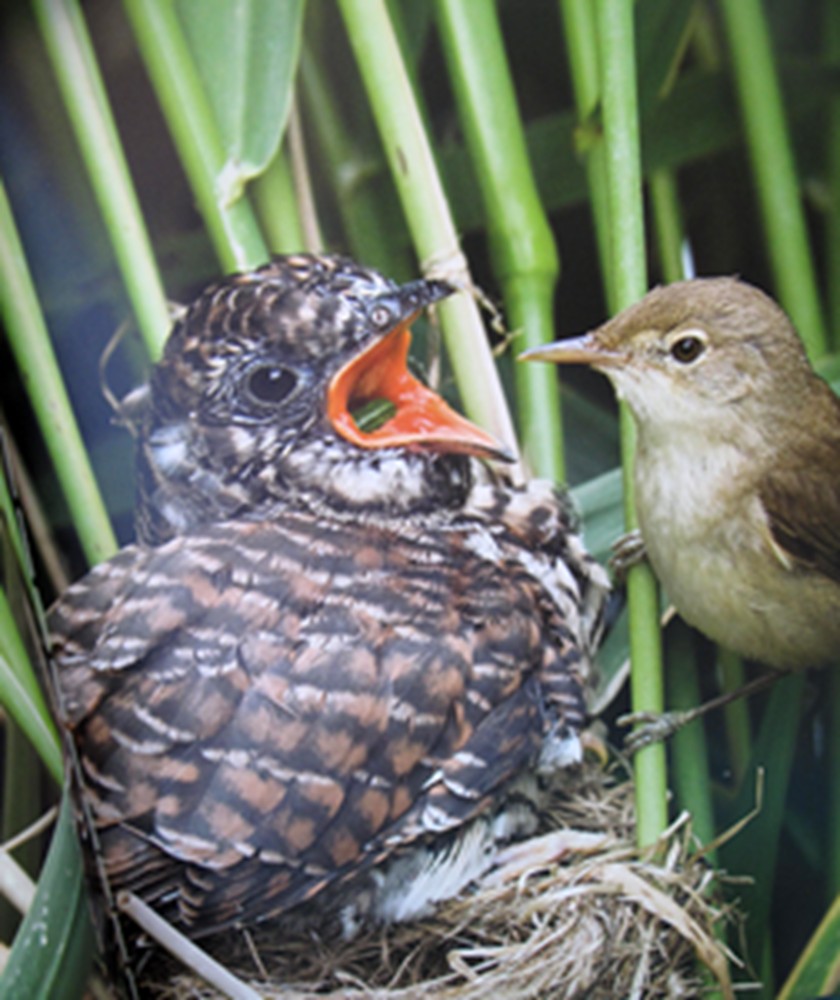
I think one reason for more cuckoos this year may be the imposed lack of global human activity due to COVID-19, including the appalling traditional spring hunting/shooting season in Malta, where the cuckoo flies over. So, less shooting by horrible humans means more cuckoos make their long migration safely! Yippee. Less pesticide use may also be a positive factor in this recent resurgence, as they particularly enjoy feasting on hairy caterpillars.
The reed warbler, dunnock and meadow pipit may be less enthusiastic than me about this though, as they are the main target of the unusual ‘brood parasitism’ the cuckoo is famous for. Which basically means the female lays her eggs in other birds' nests and then simply leaves them to bring up her offspring.
Cuckoos always lay their eggs in the nest of the same species that raised them, and have evolved the ability to lay eggs that closely resemble the host bird's egg in pattern and colour, although their egg size will always be larger. She can lay up to 20 eggs each season, far more than if she was also feeding and raising them.
The cuckoo egg hatches at about 11 days, but before the host egg, and soon after hatching, the baby cuckoo manoeuvres the host eggs on to its back, and throws them out of the nest. It now has the sole attention of the small host bird, who feeds it every hour during daylight.
It grows at a rapid rate, overfilling the nest, and as soon as it fledges, usually in June or July, it makes its first migration to Africa. This is a complex journey of several thousand miles. And all this without ever meeting its parents, or being shown where and when to fly that vast distance!
We often underestimate the intelligence and ingenuity of birds, including the elusive cuckoo. I hope you heard one this year.
Damselflies and dragonflies both belong to the order of insects called Odonata, from the Greek for ‘toothed jaw’. They both have a hinged, extendable lower lip, which shoots out to impale their prey with the pincers at the tip, making them highly efficient predators.
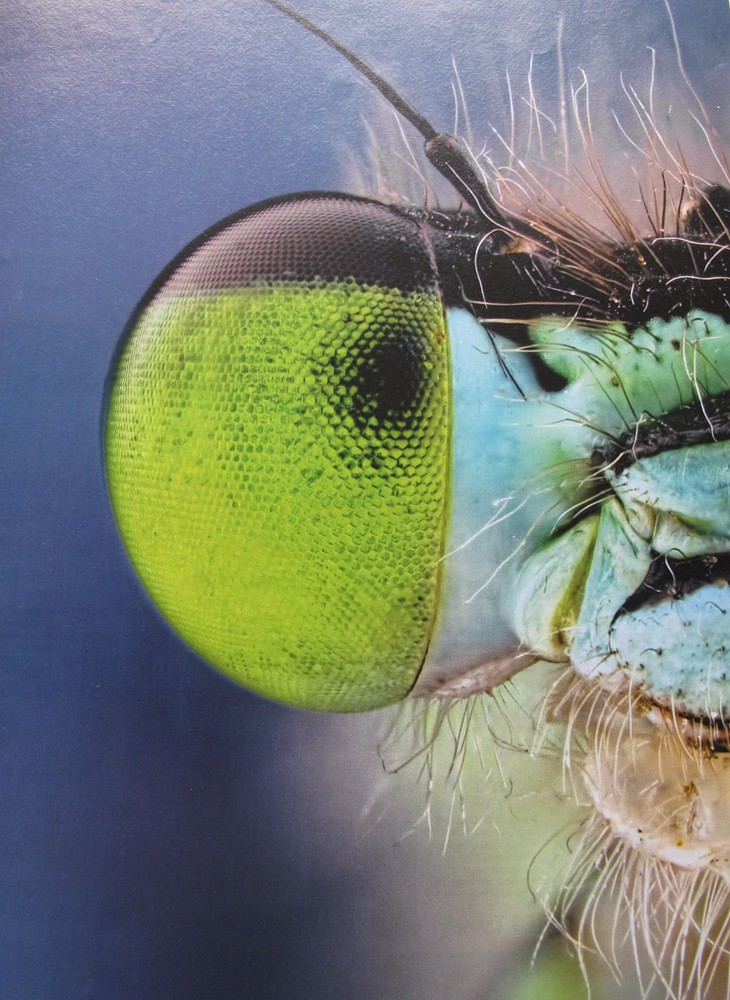
Damsels and dragons are different suborders, not male and female of the same insect, as commonly thought. Damsels are smaller than dragons, and most appear earlier than the dragons, from April.
Damsels hold their wings held close to their body as they perch, whilst dragons hold them out to the side. Damsels have two distinct, large eyes, positioned at each end of their oblong head. Each eye has up to 30,000 individual light sensitive cells, which gives them good vision. This image is a close up of the eye of the widespread Azure Damsel - not to mention the fantastically hairy face!
We have 52 species of Odonata in the UK, and fossils of dragonflies have been found in carboniferous rocks that are 350 million years old! This is the time of year to see the adults flying near freshwater, and my twin brother and I used to go off for the day, aged 6 or 7, to a big local park and lake, with empty match boxes and little nets to try to bring some home….. we only ever caught one, and it flew off as soon as we opened the box.
Damsels lay individual, cigar-shaped eggs into the stems of aquatic plants, which helps to protect them from predators. They spend most of their life as carnivorous, developing nymphs in water, only living up to a month as a flying adult, with the sole intention of mating.
But if you sit quietly by fresh water in July, you may be rewarded with the marvellous sight of a damsel or dragon, briefly on the wing as an adult, looking for a mate. A true sign of summer.
We have two native seahorses in the UK, the Short Snouted Seahorse (Hippocampus Hippocampus) and the Spiny or Long Snouted Seahorse (Hippocampus Guttalatus). The image here is of a Spiny Seahorse, with clearly visible, extra-long spines on the head.
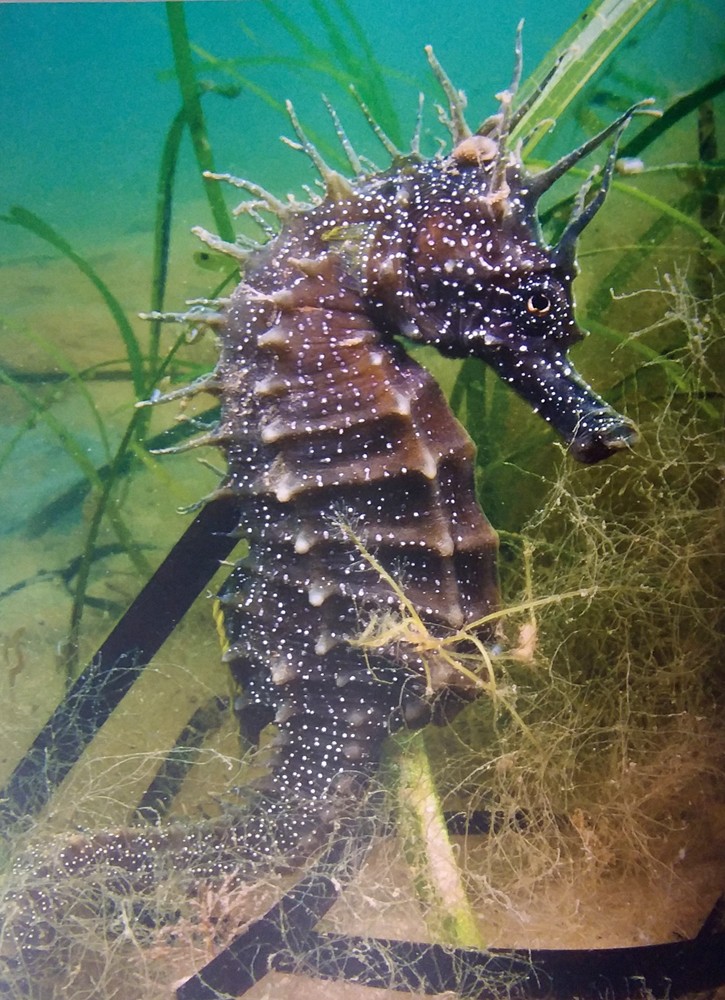
They are a rare sighting, but are fairly widespread in shallow, inshore waters all around our coast, right up to the Shetland Isles. Although they resemble horses and swim in an upright, vertical position, they are tiny fish. But they are surprisingly poor swimmers, relying only on their small dorsal fin to propel them forward. It beats at up to 70 times a second, which seems a lot, but they only move slowly through their favoured calm, warm waters, mainly on the southern coasts.
Their most extraordinary, unique fact is one we all know- it is the male who carries the developing young - the only male creature on earth to have a true pregnancy. And we still don’t know why this is!
The males vie with each other for a female, and they mate for life. They maintain strong bonds with each other by a daily dance, where they spiral around each other for up to an hour every morning. When mating, the female transfers her eggs to him by her ovipositor, and he then self fertilizes them within his body with his sperm. He can carry hundreds of fertilized eggs in his pouch for up to a month, and then gives birth to tiny, live young seahorses. They need the cover of good amounts of seagrass to help them survive when very young.
Once they are born, the seahorses, known as fry, have to fend for themselves, and are very vulnerable to predation, so their numbers are quickly reduced. Luckily, seahorses are able to change colour, so they can camouflage themselves, and disappear as much as possible within their surroundings, often almost invisible in the seagrass and eelgrass beds they are hiding within.
Seahorses also have a prehensile tail, which they can wrap around underwater foliage, to stop them being swept away in stronger currents and rough seas. They also have unusual vision, as their eyes act independently of each other. This means they can’t judge distance, but they can see to the front and back at the same time, keeping both eyes on the lookout for predators.
So, although tiny, they have some excellent adaptations to help them survive to adulthood, to mate for life and to continue that unique and intriguing fact of male pregnancy and birth!
Beetles are fantastically successful insects across the whole world, and belong to the order Coleoptera, which means ‘sheath wings’. Most have two pairs of wings, with the tough front pair folded over the much more delicate hind wings, forming a protective armour. Their hard outer layer is called an exoskeleton, which is waterproof and airtight, but with tiny holes called spiracles which allows it to breathe.
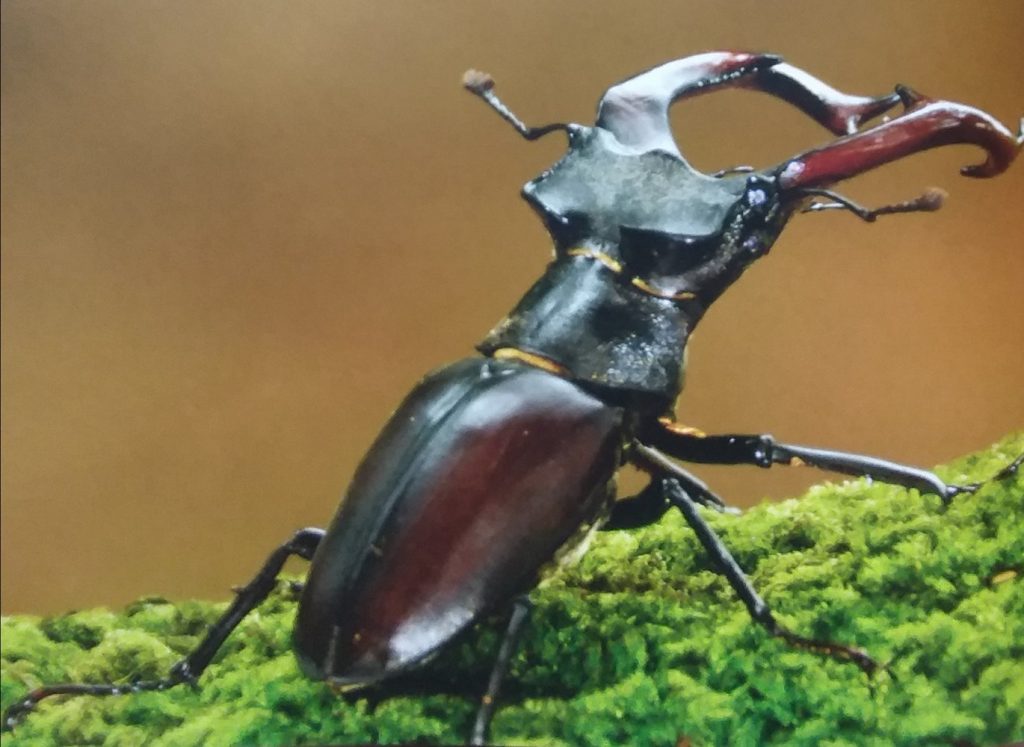
Beetles are the largest order of all insects, with more than 400,000 different types identified so far, and have biting jaws on the underside of their head, distinguishing them from bugs like aphids, which have sucking mouthparts. They are cold blooded, and control their body temperature by moving and basking in the sunshine to warm up.
We will all be familiar with the lovely, brightly coloured ladybird, a real gardeners friend, as it eats lots of aphids, but our largest beetle, at up to 9cms long, is the Stag Beetle. It well named, as the male has really impressive, large claws which resemble deer antlers. Like deer, they use these to fight with other males for the chance to mate with the females. They lock claws as each male tries to lift and overturn their rival, and then dash them to the ground. Beetle wrestling!
After mating, the female lays her eggs in rotting dead wood, and then dies. The creamy coloured grubs hatch out quickly and remain inside the dead wood, feeding on it for up to 6 years as it grows. It then burrows into the soil, turning into a pupa where it develops over winter and spring into the fully formed adult beetle, emerging in the summer.
Stage beetles are only on the wing for a few weeks, from early June to August, easily visible on warm summer evenings as they fly around, because of their large size. Gardens with untidy bits of dead wood are important habitats for this amazing beetle, but they also bask on warm pavements to heat up their bodies, which is a risky business as people often tread on them. Not much reward for such a short adult life!
So, help wildlife by allowing parts of your garden to be less tidy, and keeping some old logs that can gently rot down, providing a safe place for all sorts of useful insects to live, including our largest beetle.

At the beginning of each month, Jan Flamank will create Nature Notes that can be shared online. You can read Jan's notes below, or you can click on each picture to find a page of notes about that topic that you can download.
Be aware though that these pages are in a format that will not work well on small-screen devices such as smartphones or small tablets.
Here are the Nature Notes for June:
Water voles are shy and elusive rodents, and are one of our most endangered native mammals. They live in slow moving, fresh water, but as their numbers had sadly declined by more than 80 per cent in the 1990s, they are now a fully protected species in law.
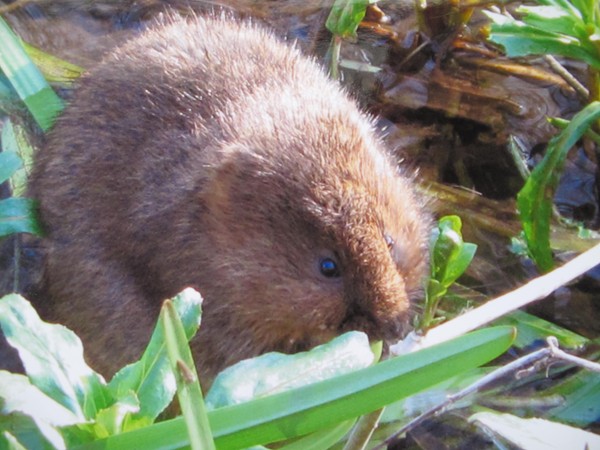
With a range of focused conservation measures, and huge amounts of work by ecologists, wildlife organisations and volunteers, their numbers have recovered in some areas. But they remain scarce and difficult to see, even in previous strongholds such as the River Wye. I was lucky enough to see and photograph this lovely vole, quietly munching on new waterside vegetation one late April, as I walked by the river into Bakewell.
They are very tidy when they eat, ensuring the stalks are free from mud before munching on it, and they hold the vegetation with dexterous, four fingered front paws. They need to eat about 80 per cent of their body weight every day, and adapt their mainly herbivorous diet to take advantage of the seasonal food available. They will eat berries that grow near water, and may also eat worms and small fish to supplement their green diet when pregnant.
Though competent swimmers, they do not have webbed feet, and because they have no waterproofing on their fur, they only stay in or under water for short periods to avoid getting a waterlogged coat.
Question: Can you identify four reasons why water voles became so endangered, and what can we all do to help their recovery?
This gorgeous, native butterfly is one of my favourites out of all our butterflies. It is small, with a wingspan of only one inch, but it shimmers with such beauty, and I remember trying to count the orange spots on the edge of the wings as an excited, small child.
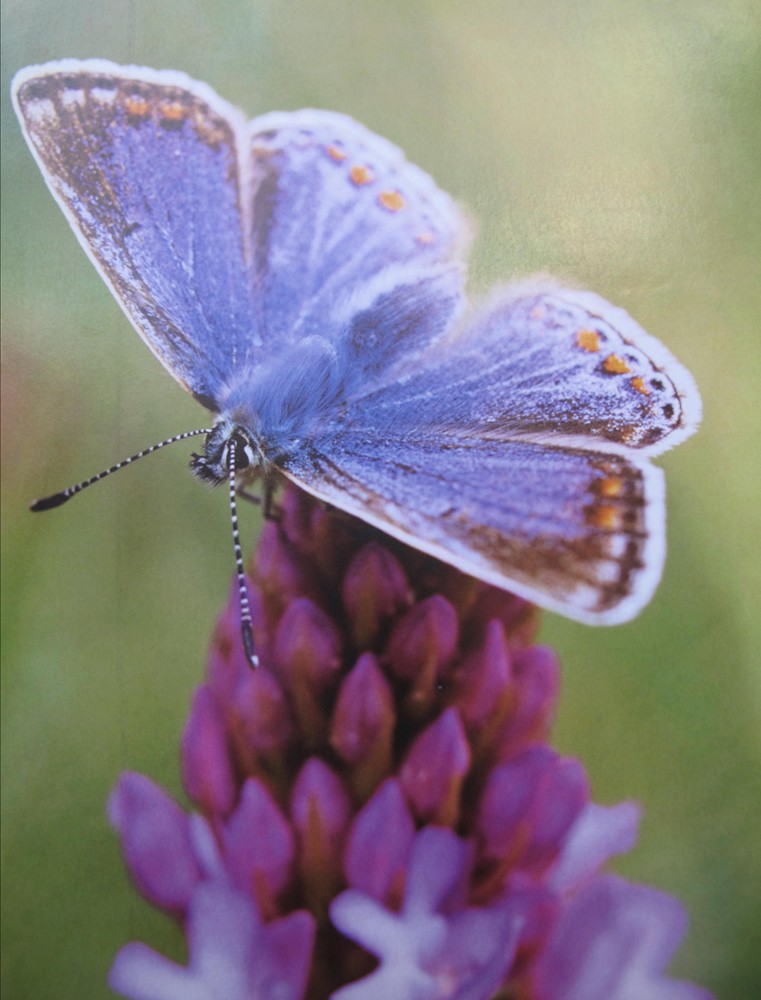
This lovely butterfly has declined so much it cannot now live up the name of being a common sight. Previously widespread from North Africa to the Arctic, the usual fatal combination of loss of habitat, overuse of pesticides, herbicides and intensive farming have all taken their toll on the Common Blue. More roads and housing also impact negatively on butterflies, along with many other native species.
One of seven species of blue butterflies in Britain, they emerge as adult butterflies from June, and all have very specific plants on which they lay their eggs. Most of these are wild flowers, which are in decline themselves. As ever, if we don’t have a richly diverse plant population, with healthy soil, then the whole food chain suffers.
The caterpillars of the Common Blue feeds mainly on clover, birdsfoot- trefoil and rest harrow. They are bright green with a distinctive black head, a dark line down their back and paler stripe at each side of their body. In our fabulous North, they will only have one brood usually, but with global warming they may catch up with their Southern relatives, who can have up to three broods each year. Autumn caterpillars are able to overwinter, and emerge the following spring.
Question: How can gardeners and farmers best support our native butterflies, and those migrating to us across the water?
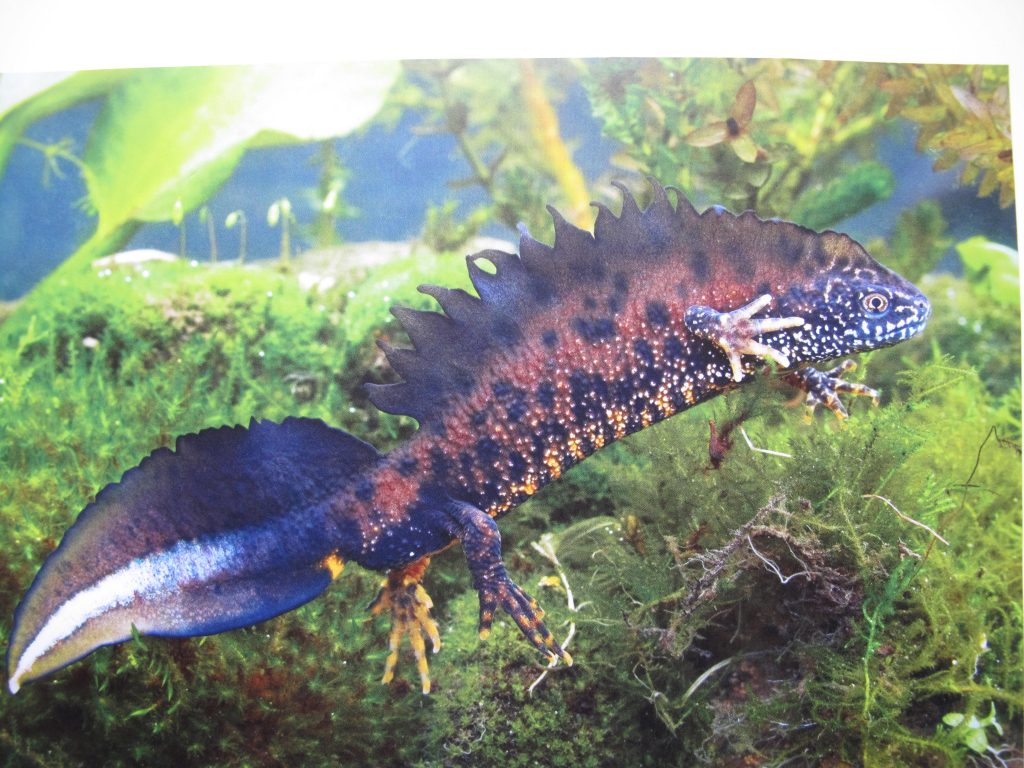
As a semi -aquatic, amphibian species, they spend most of their adult life on the ground, but mating always occurs in water. The males are easy to distinguish from females during the mating season, as they develop a fantastic, rather outlandish crest along their back to demonstrate how healthy and desirable they are.
This crest, a newt version of a wild haircut, is accompanied by large, dark spots all over their back, flanks and tummy, which has already brightened to a deep orange colour. They also have a white flash on their tail, which they wave seductively when wooing a female, and use to waft their scent across the water to her. The opening to their male reproductive organs, the cloaca, also enlarges to give a much bigger, newt posing pouch. Males also have frilly toes when mature.
All these changes in the males are to display their health and strength, and increase their chance of being chosen by the female. She simply wants their offspring to have the best chance of survival.
The female lays fertilized eggs one at a time, and carefully wraps each one in a leaf to stop them being carried away by water currents. The eggs hatch in about 3 weeks, and these small larvae already have frilly gills, similar to tadpoles. As with tadpoles, these gills degrade as their internal lungs develop to allow them to breathe air on land. Unlike frogs and toads, newts develop their front legs first, and then their back legs. Immature newts are called efts, and take up to three years to be fully mature, growing up to 6½ inches in length.
Question: What do newts feed on as efts, and what do they feed on when fully grown?
One of our most successful native, solitary bees, the Red Mason Bee is common across England, Wales and southern Scotland. Often overlooked, solitary bees represent up to 95% of the world bee population, and we have over 275 species of all bees across the UK.
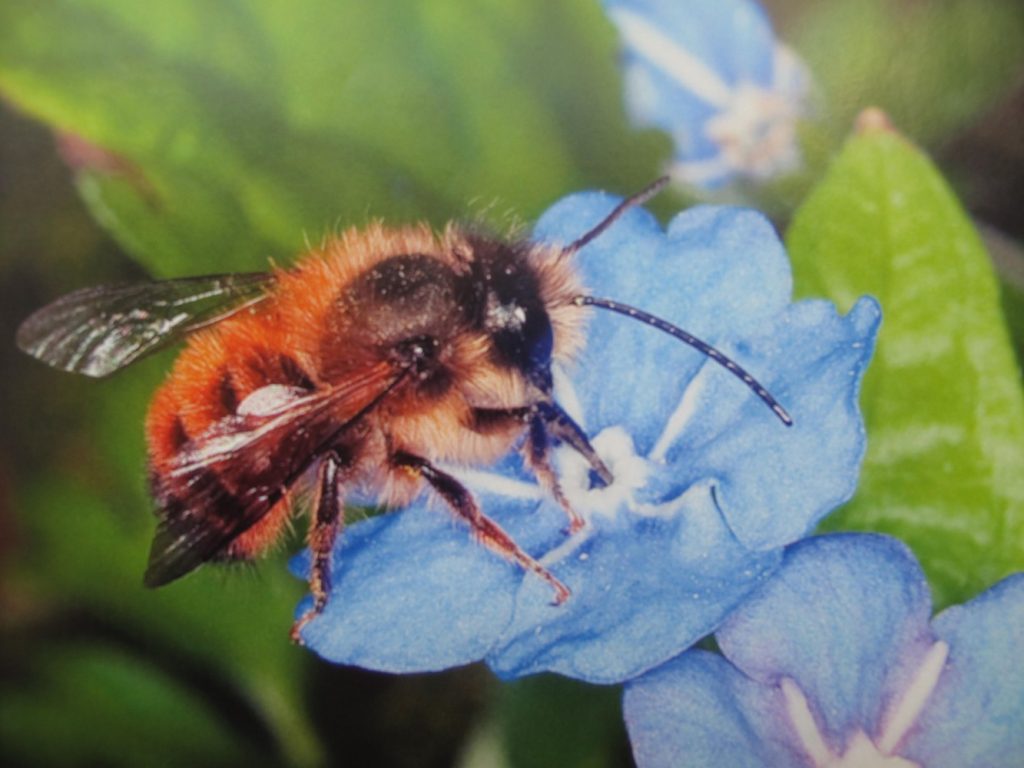
They are important pollinators, but can be rather fussy feeders, often preferring only a few wildflowers. Red Mason bees are very efficient at pollinating orchard trees, as the females carry their pollen on the underside of their tummy. This makes them a bit messy, which helps to transfer pollen between flowers, rather than kept safe in pollen sacs on the legs of social bees.
They have a fascinating life cycle, which is easy to observe if you have a bee ‘hotel’ or nest box in your garden. They readily use these, made of bamboo or holes drilled in wood, as well as using holes in bricks and masonry, which is where their name comes from. They do not have a sting, so I have no worries about them being next to my back door, and I can watch them as they make themselves at home.
Adult bees emerge from their cocoons in late April and May, and they mate soon after. The male dies, his job done, and the female lays her eggs, often in the same place she started life as an egg. She backs into the brood cell to lay her egg deep in the narrow space, and then places a marvellous hamper of food for the egg - a parcel of pollen and nectar that it will feed on as it develops into a grub. After leaving this hamper of goodies, the female seals up the cell entrance with mud, which she collects and ferries to the nest.
Watching them by my kitchen door, it is clear how industrious she is, making sure the entrance is fully sealed with mud, protecting the egg she has laid.
The grub, or larva, full of the pollen and nectar left by its mum, then pupates and overwinters in a cocoon it spins for itself. The adult bee is fully formed by the autumn, but spends the colder winter safe and snuggly in the protective cocoon. It comes out of the cell in late spring, almost exactly a year after it was first laid as a tiny egg.
Question: How can gardens be made into better habitats for solitary bees?
© Jan Flamank June 1st 2020.
All rights reserved.
Images used in the document have been sourced free for use in this social, educational, non-commercial setting
Steve Edwards is executive director at South Yorkshire Passenger Transport Executive. Click this link to read his message to all people who use public transport across the county on how they can help they play a part in our recovery from the setbacks caused by Coronavirus/COVID-19

STANNINGTON LIBRARY WILL REMAIN CLOSED FOR THE FORESEEABLE FUTURE, BUT PLANS ARE BEING PUT IN PLACE FOR OUR RETURN WHEN THE CORONAVIRUS/COVID-19 SITUATION PERMITS
Here is a statement of the current situation:
All the volunteer libraries are busy discussing arrangements for re-opening if and when the COVID-19 situation permits it. But there are many things to consider and no decisions have yet been made.
Sheffield Libraries have not made any announcements yet, but we are following developments closely and talking to them about the safest possible ways of operating our libraries in line with public health guidance. All concerned will want full confidence in those procedures before returning. Ensuring the safety of our volunteers and our users will remain our primary aim.
Stannington Library is a small space and we need to think carefully about how social distancing can be observed. All libraries have to work out ways of ensuring that all books are clear of infection before they are taken out, and again when they are returned. We are looking at how to ensure safe loans and returns for people using the RFID self-service kiosk, as well as for borrowing ‘yellow sticker’ books.
It is unlikely that any change to the current status of the library will happen before July at the earliest, but we will make announcements as soon as we can. Please watch this space.
Also, please keep checking the RESOURCES page of our website (https://stanningtonlibrary.com/resources-page/), our public Facebook page and/or our Twitter account (@booksSTAND) where we continue to share links to interesting, informative and entertaining online content. See also Sheffield Libraries’ e-library page where you can borrow e-books, e-audio books and other material using your library card. Follow this link https://bit.ly/2z0UA34_e-library
As soon as we can speak with certainty about re-opening, we will. But much work has to be done, by ourselves and by official bodies at various levels, before we will be able to do that.
IF YOU HAVE ANY QUESTIONS TO YOU WOULD LIKE TO ASK, PLEASE EMAIL [email protected]

Stannington Library is managed by
